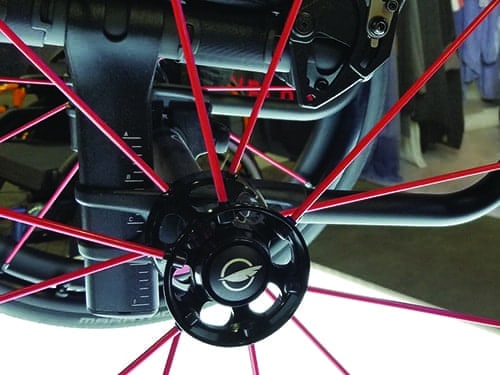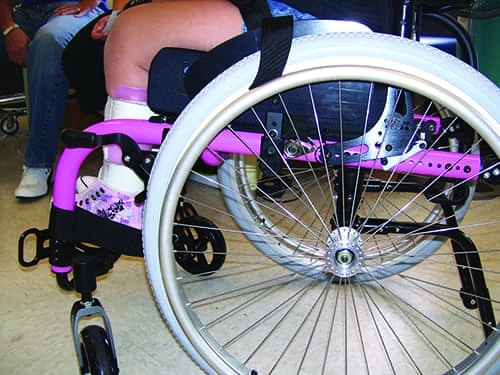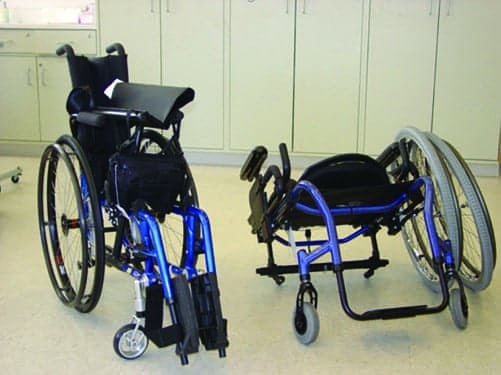by Susan Johnson Taylor, OTR/L
Combining the information from the client evaluation, knowledge about the components of manual wheelchairs, and their effects on function and understanding of the geometry of configuring manual wheelchairs (MWC) lead to successful interventions. The main reason therapists must individually configure a wheelchair to a client is to decrease work. While propelling a MWC obviously involves work, there should be as little as possible. The more work, the more effort and fatigue.
It is well documented that there is a relationship between improving the performance of a manual wheelchair through fine adjustment and facilitation of functional propulsion and joint protection.1-8 What is “functional propulsion”? Functional propulsion includes accomplishing ADLs and IADLs without impacting endurance and ability to function throughout the day; propelling without pain (joint protection); and propelling without deleterious effects on posture and skin.9 Prescribing an individually configured MWC requires that the clinical team understands the effects of configuration on their client’s function. While there are many considerations, we will focus only on several wheelchair and seating-related points.

Center of gravity: The way the wheel adjusts differs from wheelchair to wheelchair, but the functions remain the same. It allows movement of the wheel forward and backward to bring the wheel into ideal propelling position, to as well as up and down do the same, plus change the rear seat to floor height.

Caster assembly: It must always be perpendicular to the ground for appropriate and safe performance.

Fixed tilt: Movement of the wheel up and down allows changing the rear seat to floor height to create “fixed tilt.”
Components and Configuration Come First
With a new user, the seating components and configuration must be determined prior to adjusting the wheelchair. The linear and angular measurements of the client and therefore the seating, as well as the position in space/ability to balance, must then be translated to appropriate MWC measurements and set up. This includes the body weight-bearing components of the seat, back support, foot support, and armrests.10 With an experienced rider, any issues about seating that arise should be addressed prior to dealing with wheelchair frame configuration issues.
Most adjustments that affect function occur at the axle and the caster. There are several functions that can occur at the axle. Two of them that affect position of the person in the wheelchair and ability to propel include:
• Center of gravity, the “fore” and “aft” adjustment, to maintain good alignment and balance of the client relative to the rear wheel. Even small adjustments in fore and aft make a huge functional difference.
• Rear seat to floor height, the “up” and “down” adjustment.
The caster assembly (caster wheel, caster fork, and caster stem bolt) dictate the front seat to floor height. The caster stem bolt (this attaches the caster and fork to the wheelchair, in different ways, depending on the design of the wheelchair) must always be perpendicular to the ground, or the caster will end up being “wobbly,” unstable, and difficult to push.
To achieve “fixed tilt,” or the front seat to floor height higher than the rear seat to floor height, the axle must be raised to lower the rear seat to floor height. This is a key adjustment in accommodating a client’s need for stability due to such causes as poor trunk control. Whenever the rear seat to floor height is changed, the caster must be re-squared to ensure that it performs smoothly.
The biggest differences between rigid and folding frames from a performance adjustment standpoint are rigidity of the frame, weight of the frame, how they fold and the size and shape of the folded wheelchair, and the ability to have footrest adjustment and flexibility. A rigid frame chair has fewer moving parts than a folding frame, allowing more of the energy to go into propelling. They also tend to be lighter, which assists with propulsion and lifting the wheelchair into a vehicle. Rigid frame and some folding frame wheelchairs also allow the adjustment of the seat to back angle to match the client’s thigh to trunk angle. It is essential to take accurate relative angle measurements during the evaluation process to ensure that the angles created by the client’s body match the wheelchair.
Client Complaints Are Clues
Generally, therapists discover a client’s manual wheelchair needs adjustment by the client’s complaints combined with visual cues the wheelchair provides. The clinical team needs to understand both of these for a successful client intervention.
Among the functional complaints therapists may need to interpret are:
• “Every time I come to the front edge of my seat to transfer, the whole wheelchair wants to tip forward.”
• “When I am propelling down a hill, my right caster starts wobbling.”
• “I feel like I have to reach back so far to get the wheel.”
• “It’s hard to push my wheelchair. I feel like there is a lot of resistance.”
• “My wheelchair keeps wanting to push to the left all the time.”
Visual inspection of the client in the wheelchair and the wheelchair itself can reveal issues as well. Has the client’s weight or, more importantly sometimes, weight distribution changed? For example, if a client has gained weight mostly in the upper body, this could change their relationship to the rear axle and therefore the rear wheel for effective propulsion. If the client has a changeable condition, has the client lost strength and function? Can, for example, adjustments to the rear wheel assist in accommodating this?
When the client is talking about problems with propulsion or performance, and/or the wheelchair visually looks “off,” the ATP/supplier takes sets of measurements that can include measuring outside of wheel to wheel at the front/back, top, bottom, to ensure they are in proper alignment, and see if the caster is squared.

(Top) A rigid frame has fewer moving parts than a folding frame, allowing more of the energy to go into propelling. (Below) K0005 wheelchairs allow accommodation of varying angles and linear measures created by the functional position of a client’s body.
Solving the Pressure Injury Puzzle
If there appears to be an issue with pressure injuries involving shear, materials such as viscous fluids and air can be considered to decrease the effects of shear. Offloading an area completely is another strategy to deal with a tendency toward or history of pressure injuries at the ischial tuberosities. In either case, the effects of cushion choice on the client must be carefully evaluated.
Pressure mapping can assist in deciding between cushions when there is an existing or potential for pressure injuries. Some systems allow remote collection of data, so that the map can be looked at while the client moves, propels, and functions in the wheelchair. When pressure mapping, a consistent protocol must be used to ensure immersion and envelopment have occurred in the cushion. With the introduction of each cushion to pressure map, the clinical team must ensure the wheelchair has been adjusted appropriately. Pressure mapping can also be useful for client education, and determining whether the client is performing an effective pressure relief.
Effects of Propulsion on Posture
Once the wheelchair alignment and seating configuration are completed, observation of the propelling to observe the effects of propulsion on posture should be next. With new clients this may be done during the trial equipment phase of the evaluation. Experienced riders will likely have an idea at the beginning of the evaluation as to whether there are issues with posture or pressure injuries. Either way, this may result in further small adjustments. For newer riders, there are resources to allow training in handling the manual wheelchair, such as performing a safe and functional wheelie. A well-adjusted piece of equipment requires training with how to use it. The Wheelchair Skills Program is an excellent resource.11 RM
Susan Johnson Taylor, OTR/L, has been practicing in the field of seating and wheeled mobility for 38 years, primarily in the Chicago area at the Rehabilitation Institute of Chicago (now the Shirley Ryan AbilityLab) Wheelchair and Seating Center. She has published and presented nationally and internationally and is both a member of and fellow with RESNA. She is currently a member of the RESNA/ANSI Wheelchair Standards Committee and the Clinician Task Force. Taylor joined Numotion in 2015 as the manager of training and education. For more information, contact [email protected].
References
1. Lange M and Minkel J (eds). Seating and Wheeled Mobility: A Clinical Resource Guide. Slack: 11/17.
2. de Groot S, Vegter RJ, van der Woude LH. Effect of wheelchair mass, tire type and tire pressure on physical strain and wheelchair propulsion technique. Med Eng Phys. 2013;Oct 35(10):1476-82
3. Boninger ML, Waters RL, Chase T, et al. Preservation of upper limb function for individuals with spinal cord injury. J Spinal Cord Med. 2005;28(5):434-470.
4. Sprigle S, Huang M. Impact of mass and weight distribution on manual wheelchair propulsion torque. Assist Technol. 2015 Winter;27(4):226-35; quiz 236-7.
5. Requejo PS, Mulroy SJ, Ruparel P, et al. Relationship between hand contact angle and shoulder loading during manual wheelchair propulsion by individuals with paraplegia. Top Spinal Cord Inj Rehabil. 2015 Spring;21(4):313-24.
6. van der Woude LH, Veeger DJ, Rozendal RH, Sargeant TJ. Seat height in handrim wheelchair propulsion. J Rehabil Res Dev. 1989 Fall;26(4):31-50.
7. Boninger ML, Souza AL, Cooper RA, Fitzgerald SG, Koontz AM, Fay BT. Propulsion patterns and pushrim biomechanics in manual wheelchair propulsion. Arch Phys Med Rehabil. 2002 May;83(5):1718-23.
8. Boninger ML, Baldwin M, Cooper RA, Koontz A, Chan L. Manual wheelchair pushrim biomechanics and axle position. Arch Phys Med Rehabil. 2000;81(5):608-13.
9. Cowan RE, Boninger ML, Sawatzky BJ, Mazoyer BD, Cooper RA. Preliminary outcomes of the SmartWheel Users’ Group database: a proposed framework for clinicians to objectively evaluate manual wheelchair propulsion. Arch Phys Med Rehabil. 2008 Feb;89(2):260-8.
10. Waugh K, Crane B, Taylor S, Davis K, Cwertnia S. A clinical application guide to standardized wheelchair seating measures of the body and seating support surfaces. Published by the University of Colorado, Assistive Technology Partners, through a grant from the Paralyzed Veterans Association. 2012, revised July 2013
11. Dalhousie University Faculty of Medicine Wheelchair Skills Program. Available at: www.wheelchairskillsprogram.ca. Accessed March 13, 2019.





